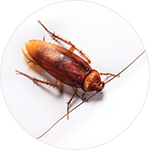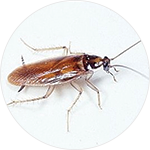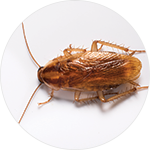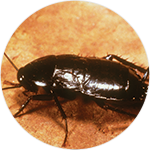American Cockroach
 Color: Reddish-brown, with a yellowish figure 8 pattern on the shield behind the head
Color: Reddish-brown, with a yellowish figure 8 pattern on the shield behind the head
Legs: 6
Shape: Oval
Size: Up to 2 inches long
Antennae: Yes
Region: Found throughout the U.S. and world
The American cockroach, or palmetto bug,” is the largest of the house infesting cockroaches. Despite its name, the American cockroach is not native to North America, but was probably introduced via ships from Africa in the 1600s.
Habits
Although American cockroaches can be found in homes, they are also common in larger commercial buildings such as restaurants, grocery stores, food processing plants and hospitals. They are known to infest food storage and food preparation areas, as well as basements, yards and alleys. In Northern climates the most common route into structures is through drains and sewer pipes. In the south, they may live outdoors and come in from the exterior.
Habitat
Although American cockroaches can be found in homes, they are also common in larger commercial buildings such as grocery stores, food processing plants and hospitals. American roaches are also known to infest basements, yards and alleys, especially in tropical to semi-tropical environments.
Threats
Cockroaches have been reported to spread at least 33 kinds of bacteria, six kinds of parasitic worms and at least seven other kinds of human pathogens. They can pick up germs on the spines of their legs and bodies as they crawl through decaying matter or sewage and then carry these onto food or food surfaces. They can contaminate food and surfaces with their feces and body parts.
Prevention
The best advice for American cockroach control is to practice exclusion and good sanitation. Seal entry points and correct any moisture problems. Keep floors, equipment and counter tops clean to reduce available food sources. Special drain caps with one way valves are available to keep cockroaches from coming into living spaces from sewers and should be considered. If there is evidence of a cockroach infestation, contact a licensed pest management professional to inspect and treat the American cockroach problem.
Brownbanded Cockroach
 Color: Brown, with pronounced banding across wings
Color: Brown, with pronounced banding across wings
Legs: 6
Shape: Oval
Size: Up to ½ inches long
Antennae: Yes
Region: Found throughout the U.S.
Brownbanded cockroaches get their name from the two lighter bands they have across their dark brownish bodies. Male brown-banded roaches have full wings that reach beyond the tip of their pointed abdomens, but females have underdeveloped wings that prohibit them from flying. The brown-banded cockroach can live for about 206 days. This cockroach is not as common as other species, but may be encountered in multi-unit dwellings or other residential buildings.
Habits
The adult male of this cockroach species can fly; this helps distinguish this species from the more common German cockroach, which is similar in size. They will feed on a variety of items including non-food items like glue.
Habitat
Brownbanded cockroaches can be found throughout structures, but show a preference for drier locations and warmer areas over 80⁰. This cockroach is more common in residences than commercial buildings due to its environmental preferences. They also tend to prefer higher locations than most cockroach species and are often found in upper cabinets in kitchens and bathrooms. Brownbanded cockroaches often hide their egg cases in or under furniture and glue the oothecae (egg cases) to surfaces.
Threats
Brownbanded cockroaches can contaminate food and damage non-food items through their feeding and presence.
Prevention
The best advice for Brownbanded cockroach control is to practice good sanitation and exclusion. To prevent Brownbanded cockroaches from infesting your space, keep available food to a minimum, seal all entrances around utility pipes and other areas where the cockroach may move from one unit to the next. If there is evidence of a cockroach infestation, contact a licensed pest management professional to inspect and treat the Brownbanded cockroach problem.
German Cockroach
 Color: Light brown to tan, with two dark, almost parallel stripes located on their backs, just behind their heads
Color: Light brown to tan, with two dark, almost parallel stripes located on their backs, just behind their heads
Legs: 6
Shape: Oval
Size: 1/2 – 5/8 inches long
Antennae: Yes
Region: Found throughout the U.S.
The German cockroach is the most common species of cockroach, found all over the world. German cockroaches prefer to live in cracks and crevices near food and moisture sources, hence their affinity for residential and commercial kitchen environments.
Habits
German cockroaches will feed on almost anything, including soap, glue and toothpaste. German cockroaches are good hitchhikers and often find their way into new structures via cardboard boxes, drink cartons and secondhand appliances. They may move through structures via wall voids and infest apartments and offices through these travel paths. In commercial facilities, a common way for them to enter structures is on employee belongings.
Habitat
German cockroaches prefer to live in warm, humid places close to food and moisture sources. They are frequently found in residential and commercial kitchen environments and bathrooms.
Threats
In addition to being a nuisance, the German cockroach has been implicated in outbreaks of illness and allergic reactions in many people. Cockroaches have been reported to spread at least 33 kinds of bacteria, six kinds of parasitic worms and at least seven other kinds of human pathogens. Medical studies have shown that cockroach allergens cause allergic reactions in children and can exacerbate asthma attacks. They can contaminate food and damage surfaces with their feces and presence.
Prevention
Exclusion is the first step in trying to prevent these pests from even entering your home or facility. Seal around pipe/wall junctures and other openings where the cockroaches may enter from neighboring units to ensure that cockroaches are not introduced on boxes or other items. In commercial facilities, make sure that employees store personal items in a designated area which will help confine any hitchhiking pests to that area. Inspect incoming goods, keep food and food spills to a minimum and practice good sanitation. If despite your efforts, German cockroaches are found, contact a licensed pest management professional for assistance.
Oriental Cockroach
 Color: Shiny black
Color: Shiny black
Legs: 6
Shape: Oval
Size: 1 inch long
Antennae: Yes
Region: Northern regions of the U.S.
Oriental cockroaches live in sewers and in wet, decaying organic matter. They are sometimes called “waterbugs” because they come out of drains, and “black beetle cockroaches” because of their smooth, dark bodies. The immature stages or nymphs are sometimes confused with the immature stages of the American cockroach since they look very similar.
Habits
Oriental cockroaches can survive quite well outdoors, where they can be found under debris, leaves, stones and porches or in wall voids. They can enter homes through door thresholds, under sliding glass doors, along utility pipes and air ducts and from floor drains. Inside homes, Oriental cockroaches tend to hide in crawl spaces, basements and around utility pipes. Oriental cockroaches feed on all kinds of food, especially decaying organic matter and starchy foods.
Habitat
Outside, Oriental cockroaches are often found in sewers and under debris, leaves, stones and firewood. They will enter structures through door thresholds, under sliding glass doors, along utility pipes and through floor drains. Once indoors, Oriental cockroaches find harborage in basements and crawl spaces.
Threats
These cockroaches can contaminate food and damage surfaces with their feces. Although not thoroughly researched, mechanical transmission of pathogens is suspected since these cockroaches often live in environments like sewers where disease organisms are present. They are likely to pick up germs on the spines of their legs and bodies as they crawl through decaying matter or sewage and then carry these into food or onto food surfaces.
Prevention
Exclusion and sanitation are two important elements in Oriental cockroach control programs. Since they can be found outside, sealing the structure to prevent entry can be an important part of the program. Keeping available food sources to a minimum is also important through good sanitation practices. Lastly, reduce moisture sources through elimination of pipe leaks and poor drainage systems. If there is evidence of a cockroach infestation, contact a licensed pest management professional to inspect and treat the Oriental cockroach problem.
